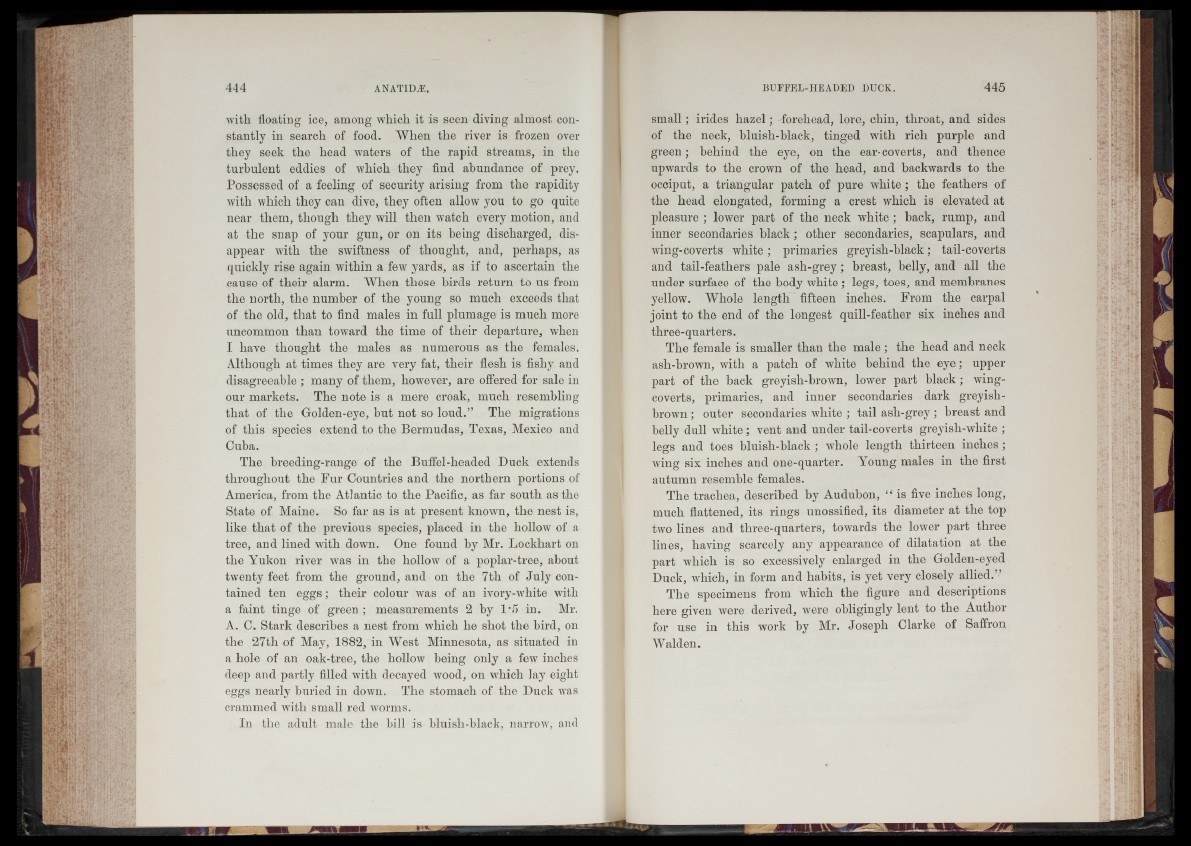
with floating ice, among which it is seen diving almost, constantly
in search of food. When the river is frozen over
they seek the head waters of the rapid streams, in the
turbulent eddies of which they find abundance of prey.
Possessed of a feeling of security arising from the rapidity
with which they can dive, they often allow you to go quite
near them, though they will then watch every motion, and
at the snap of your gun, or on its being discharged, disappear
with the swiftness of thought, and, perhaps, as
quickly rise again within a fewr yards, as if to ascertain the
cause of their alarm. When these birds return to us from
the north, the number of the young so much exceeds that
of the old, that to find males in full plumage is much more
uncommon than toward the time of their departure, when
I have thought the males as numerous as the females.
Although at times they are very fat, their flesh is fishy and
disagreeable ; many of them, however, are offered for sale in
our markets. The note is a mere croak, much resembling
that of the Golden-eye, but not so loud.” The migrations
of this species extend to the Bermudas, Texas, Mexico and
Cuba.
The breeding-range of the Buffel-headed Duck extends
throughout the Fur Countries and the northern portions of
America, from the Atlantic to the Pacific, as far south as the
State of Maine. So far as is at present known, the nest is,
like that of the previous species, placed in the hollow of a
tree, and lined with down. One found by Mr. Lockhart on
the Yukon river was in the hollow of a poplar-tree, about
twenty feet from the ground, and on the 7th of July contained
ten eggs; their colour wTas of an ivory-w'hite with
a faint tinge of green ; measurements 2 by 1*5 in. Mr.
A. C. Stark describes a nest from which he shot the bird, on
the 27th of May, 1882, in West Minnesota, as situated in
a hole of an oak-tree, the hollow being only a few inches
deep and partly filled with decayed wood, on which lay eight
eggs nearly buried in down. The stomach of the Duck was
crammed with small red worms.
In the adult male the bill is bluish-black, narrow, and
small; irides hazel; forehead, lore, chin, throat, and sides
of the neck, bluish-black, tinged with rich purple and
green; behind the eye, on the ear- coverts, and thence
upwards to the crown of the head, and backwards to the
occiput, a triangular patch of pure white ; the feathers of
the head elongated, forming a crest which is elevated at
pleasure ; lower part of the neck white ; back, rump, and
inner secondaries black; other secondaries, scapulars, and
wing-coverts white; primaries greyish-black; tail-coverts
and tail-feathers pale ash-grey ; breast, belly, and all the
under surface of the body white; legs, toes, and membranes
yellow. Whole length fifteen inches. From the carpal
joint to the end of the longest quill-feather six inches and
three-quarters.
The female is smaller than the male ; the head and neck
ash-brown, with a patch of white behind the eye; upper
part of the back greyish-brown, lower part black ; wing-
coverts, primaries, and inner secondaries dark greyish-
brown ; outer secondaries white ; tail ash-grey ; breast and
belly dull white; vent and under tail-coverts greyish-white ;
legs and toes bluish-black ; whole length thirteen inches ;
wing six inches and one-quarter. Young males in the first
autumn resemble females.
The trachea, described by Audubon, “ is five inches long,
much flattened, its rings unossified, its diameter at the top
two lines and three-quarters, towards the lower part three
lines, having scarcely any appearance of dilatation at the
part which is so excessively enlarged in the Golden-eyed
Duck, which, in form and habits, is yet very closely allied.”
The specimens from which the figure and descriptions
here given were derived, were obligingly lent to the Author
for use in this work by Mr. Joseph Clarke of Saffron
Walden.